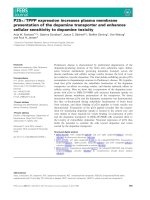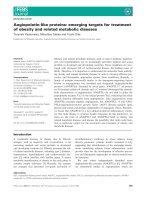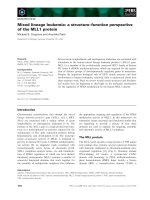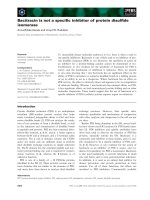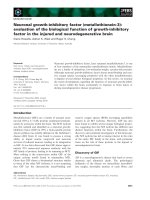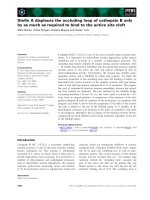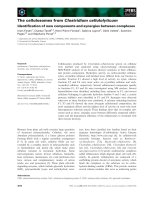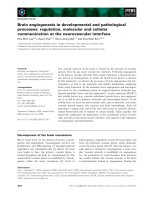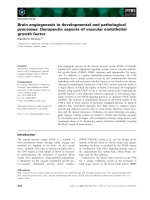Tài liệu Báo cáo khoa học: "Prosodic Aids to Syntactic and Semantic Analysis of Spoken English" ppt
Bạn đang xem bản rút gọn của tài liệu. Xem và tải ngay bản đầy đủ của tài liệu tại đây (708.57 KB, 8 trang )
Prosodic Aids to Syntactic and Semantic Analysis of Spoken English
Chris Rowles and Xiuming Huang
AI Systems Section
Australia and Overseas Telecommunications Corporation
Telecommunications Research Laboratories
PO Box 249, Clayton, Victoria, 3168, Australia
Internet:
ABSTRACT
Prosody can be useful in resolving certain lex-
ical and structural ambiguities in spoken English.
In this paper we present some results of employ-
ing two types of prosodic information, namely
pitch and pause, to assist syntactic and semantic
analysis during parsing.
1. INTRODUCTION
In attempting to merge speech recognition
and natural language understanding to produce a
system capable of understanding spoken dia-
logues, we are confronted with a range of prob-
lems not found in text processing.
Spoken language conversations are typically
more terse, less grammatically correct, less well-
structured and more ambiguous than text (Brown
& Yule 1983). Additionally, speech recognition
systems that attempt to extract words from
speech typically produce word insertion, deletion
or substitution errors due to incorrect recognition
and segmentation.
The motivation for our work is to combine
speech recognition and natural language under-
standing (NLU) techniques to produce a system
which can, in some sense, understand the intent
of a speaker in telephone-based, information
seeking dialogues. As a result, we are interested
in NLU to improve the semantic recognition accu-
racy of such a system, but since we do not have
explicit utterance segmentation and structural in-
formation, such as punctuation in text, we have
explored the use of prosody.
Intonation can be useful in understanding dia-
logue structure (c.f. Hirschberg & Pierrehumbert
1986), but parsing can also be assisted. (Briscoe
& Boguraev 1984) suggests that if prosodic struc-
ture could be derived for the noun compound
Bo-
ron epoxy rocket motor chambers,
then their
parser LEXICAT could reduce the fourteen licit
112
morphosyntactic interpretations to one correct
analysis without error (p. 262). (Steedman 1990)
explores taking advantage of intonational struc-
ture in spoken sentence understanding in the
combinatory categorial grammar formalism.
(Bear & Price 1990) discusses integrating proso-
dy and syntax in parsing spoken English, relative
duration of phonetic segments being the one as-
pect of prosody examined.
Compared with the efforts expended on syn-
tactic/semantic disambiguation mechanisms,
prosody is still an under-exploited area. No work
has yet been carded out which treats prosody at
the same level as syntax, semantics, and prag-
matics, even though evidence shows that proso-
dy is as important as the other means in human
understanding of utterances (see, for example,
experiments reported in (Price et a11989)). (Scott
& Cutler 1984) noticed that listeners can suc-
cessfully identify the intended meaning of ambig-
uous sentences even in the absence of a
disambiguating context, and suggested that
speakers can exploit acoustic features to high-
light the distinction that is to be conveyed to the
listener (p. 450).
Our current work incorporates certain prosod-
ic information into the process of parsing, com-
bining syntax, semantics, pragmatics and
prosody for disambiguation 1 . The context of the
work is an electronic directory assistance system
(Rowles et a11990). In the following sections, an
overview of the system is first given (Section 2).
Then the parser is described in Section 3. Sec-
tion 4 discusses how prosody can be employed
in helping resolve ambiguity involved in process-
1. Another possible acoustic source to help
disambiguation is =segmental phonology", the ap-
plication of certain phonological assimilation and
elision rules (Scott & Cutler 1984). The current
work makes no attempt at this aspect.
ing fixed expressions, prepositional phrase at-
tachment (PP attachment), and coordinate
constructions. Section 5 shows the implementa-
tion of the parser.
2. SYSTEM OVERVIEW
Our work is aimed at the construction of a
prototype system for the understanding of spo-
ken requests to an electronic directory assis-
tance service, such as finding the phone number
and address of a local business that offers partic-
ular services.
Our immediate work does not concentrate on
speech recognition (SR) or lexical access. In-
stead, we assume that a future speech recogni-
tion system performs phoneme recognition and
uses linguistic information during word recogni-
tion. Recognition is supplemented by a prosodic
feature extractor, which produces features syn-
chronized to the word string output by the SR.
The output of the recognizer is passed to a
sentence-level parser. Here =sentence" really
means a conversational move, that is, a contigu-
ous utterance of words constructed so as to con-
vey a proposition.
Parses of conversational moves are passed
to a dialogue analyzer that segments the dia-
logue into contextually-consistent sub-dialogues
(i.e, exchanges) and interpret speaker requests
in terms of available system functions. A dia-
logue manager manages interaction with the
speaker and retrieves database information,
3. PROSODY EXTRACTION
As the input to the parser is spoken language,
it lacks the segmentation apparent in text. Within
a move, there is no punctuation to hint at internal
grammatical .structure. In addition, as complete
sentences are frequently reduced to phrases, el-
lipsis etc. during a dialogue, the Parser cannot
use syntax alone for segmentation.
Although intonation reflects deeper issues,
such as a speakers' intended interpretation, it
provides the surface structure for spoken lan-
guage. Intonation is inherently supra-segmental,
but it is also useful for segmentation purposes
where other information is unavailable. Thus, in-
tonation can be used to provide initial segmenta-
tion via a pre-processor for the parser.
Although there are many prosodic features
that are potentially useful in the understanding of
spoken English, pitch and pause information
have received the most attention due to ease of
measurement and their relative importance
(Cruttenden 1986, pp 3 & 36). Our efforts to date
use only these two feature types.
We extract pitch and pause information from
speech using specifically designed hardware
with some software post-processing. The hard-
ware performs frequency to amplitude transfor-
mation and filtering to produce an approximate
pitch contour with pauses.
The post-processing samples the pitch con-
tour, determines the pitch range and classifies
the instantaneous pitch into high, medium and
low categories within that range. This is similar to
that used in (Hirschberg & Pierrehumbert 1986).
Pauses are classed as short (less than 250ms),
long (between 250ms and 800ms) or extended
(greater than 800ms). These times were empiri-
cally derived from spoken information seeking di-
alogues conducted over a telephone to human
operators. Short pauses signify strong tum-hold-
ing behaviour, long pauses signify weaker turn-
holding behaviour and extended pauses signify
turn passing or exchange completion (Vonwiller
1991). These interpretations can vary with cer-
tain pitch movements, however. Unvoiced
sounds are distinguished from pauses by subse-
quent synchronisation of prosodic features with
the word stream by post-processing.
A parser pre-processor then takes the SR
word string, pitch markers and pauses, annotat-
ing the word string with pitch markers (low
marked as = ~ ", medium = - "and high = ^ ") and
pauses (short and long ). The markers
are synchronised with words or syllables. The
pre-processor uses the pitch and pause markers
to segment the word string into intonationally-
consistent groups, such as tone groups (bound-
aries marked as = < = and "> ") and moves (//). A
tone group is a group of words whose intonation-
al structure indicates that they form a major
structural component of the speech, which is
commonly also a major syntactic grouping (Crut-
tenden 1986, pp. 75 - 80). Short conversational
moves often correspond to tone groups, while
longer moves may consist of several tone
groups. With cue words for example, the cue
forms its own tone group.
113
Pauses usually occur at points of low transi-
tional probability and often mark phrase bound-
aries (Cruttenden 1986). In general, although
pitch plays an important part, long pauses, indi-
cate tone group and move boundaries, and short
pauses indicate tone group boundaries. Ex-
change boundary markers are dealt with in the
dialogue manager (not covered here). Pitch
movements indicate turn-holding behaviour, top-
ic changes, move completion and information
contrastiveness (Cooper & Sorensen 1977; Von-
wilier 1991).
The pre-processor also locates fixed expres-
sions, so that during the parsing nondeterminism
can be reduced. A problem here is that a cluster
of words may be ambiguous in terms of whether
they form a fixed expression or not. "Look after",
for example, means =take care of" in "Mary
helped John to look after his kid#', whereas
"look" and "after" have separate meaning in "rll
look after you do so". The pre-processor makes
use of tone group information to help resolve the
fixed expression ambiguity. A more detailed dis-
cussion is given in section 5.2.
4. THE PARSER
Once the input is segmented, moves annotat-
ed with prosody are input to the parser. The pars-
er deals with one move at a time.
In general, the intonational structure of a sen-
tence and its syntactic structure coincide (Crut-
tenden 1986). Thus, prosodic segmentation
avoids having the Parser try to extract moves
from unsegmented word strings based solely on
syntax. It also reduces the computational com-
plexity in comparing syntactic and prosodic word
groupings. There is a complication, however, in
that tone group boundaries and move bound-
aries may not align exactly. This is not frequent,
and is not present in the material used here. Into-
nation is used to limit the range of syntactic pos-
sibilities and the parser will align tone group and
move syntactic boundaries at a later stage.
By integrating syntax and semantics, the
Parser is capable of resolving most of the ambig-
uous structures it encounters in parsing written
English sentences, such as coordinate conjunc-
tions, PP attachments, and lexical ambiguity
(Huang 1988). Migrating the Parser from written
to spoken English is our current focus.
Moves input to the Parser are unlikely to be
well-formed sentences, as people do not always
speak grammatically, or due to the SR's inability
to accurately recognise the actual words spoken.
The parser first assumes that the input move is
lexically correct and tries to obtain a parse for it,
employing syntactic and semantic relaxation
techniques for handling ill-formed sentences
(Huang 1988). If no acceptable analysis is pro-
duced, the parser asks the SR to provide the
next alternative word string.
Exchanges between the parser and the SR
are needed for handling situations where an ill-
formed utterance gets further distorted by the
SR. In these cases other knowledge sources
such as pragmatics, dialogue analysis, and dia-
logue management must be used to find the
most likely interpretation for the input string. We
use pragmatics and knowledge of dialogue struc-
ture to find the semantic links between separate
conversational moves by either participant and
resolve indirectness such as pronouns, deictic
expressions and brief responses to the other
speaker [for more details, see (Rowles, 1989)].
By determining the dialogue purpose of utteranc-
es and their domain context, it is then possible to
correct some of the insertion and mis-recognised
word errors from the SR and determine the com-
municative intent of the speaker. The dialogue
manager queries the speaker if sentences can-
not be analysed at the pragmatic stage.
The output of the parser is a parse tree that
contains syntactic, semantic and prosodic fea-
tures. Most ambiguity is removed in the parse
tree, though some is left for later resolution, such
as definite and anaphoric references, whose res-
olution normally requires inter-move inferences.
The parser also detects cue words in its input
using prosody. Cue words, such as "now" in
"Now, I want to ", are words whose meta-func-
tion in determining the structure of dialogues
overrides their semantic roles (Reichman
1985).Cue words and phrases are prosodically
distinct due to their high pitch and pause separa-
tion from tone groups that convey most of the
propositional content (Hirschberg & Litman
1987). While relatively unimportant semantically,
cue words are very important in dialogue analy-
sis due to their ability to indicate segmentation
and the linkage of the dialogue components.
5. PROSODY AND DISAMBIGUATION
During parsing prosodic information is used
to help disambiguate certain structures which
cannot be disambiguated syntactically/semanti-
cally, or whose processing demands extra ef-
forts, if no such prosodic information is available.
In general, prosody includes pitch, loudness, du-
ration (of words, morphemes and pauses) and
rhythm. While all of these are important cues, we
are currently focussing on pitch and pauses as
these are easily extracted from the waveform
and offer useful disambiguation during parsing
and segmentation in dialogue analysis. Subse-
quent work will include the other features, and
further refinement of the use of pitch and pause.
At present, for example, we do not consider the
length of pauses internal to tone groups, al-
though this may be significant.
The prosodic markers are used by the parser
as additional pre-conditions for grammatical
rules, discriminating between possible grammati-
cal constructions via consistent intonational
structures.
5.1 HOMOGRAPHS
Even when using prosody, homographs are a
problem for parsers, although a system recognis-
ing words from phonemes can make the problem
a simpler. The word sense of =bank" in
"John
went to the bank"
must be determined from se-
mantics as the sense is not dependent upon vo-
calisation, but the difference between the
homograph "content" in
"contents of
a book" and
"happy and content'
can be determined through
differing syllabic stress and resultant different
phonemes. Thus, different homographs can be
detected during lexical access in the SR inde-
pendently of the Parser.
5.2 FIXED EXPRESSIONS
As is mentioned in subsection 4.1, when the
pre-processor tries to locate fixed expressions, it
may face multiple choices. Some fixed expres-
sions are obligatory, i.e., they form single seman-
tic units, for instance =look forward to" often
means "expect to feel pleasure in (something
about to happen) ''2. Some other strings may or
2. Longman Dictionary of Contemporary En-
glish, 1978.
may not form single sematic units, depending on
the context. =Look after" and "win over" are two
examples. Without prosodic information, the pre-
processor has to make a choice blindly, e.g.
treating all potential fixed expressions as such
and on backtracking dissolve them into separate
words. This adds to the nondeterminism of the
parsing. As prosodic information becomes avail-
able, the nondeterminism is avoided.
In the system's fixed expression lexicon, we
have entries such as "fix_e([gave, up], gave_-
up)". The pre-processor contains a rule to the fol-
lowing effect, which conjoins two (or more) words
into one fixed expression only when there is no
pause following the first word:
match_fix_e([FirstW, SecondWlRestW], [Fixe-
dEIMoreW]):-
no_pause in between(FirstW, SecondW),
fix_e([FirstW, SecondW], FixedE),
Match_fix_e(RestW, MoreW).
This rule produces the following segment:-
tions:
(5.1a) <-He -gave> *<^up to ^two hundred
dollars> *<-to the ^charity>**//
(5.1b) <-He Agave ^up> *<^two hundred dol-
lars> *<-for damage compensation>**//.
In (5.1a),
gave
and
upto
are treated as be-
longing to two separate tone groups, whereas in
(5.1 b)
gave up
is marked as one tone group. The
pre-processor checking its fixed expression dic-
tionary will therefore convert
up to
in (5.1 a) to
up_to, and
gave up
in (5.1b) to gave_up.
5.3 PP ATTACHMENT
(Steedman 1990 & Cruttenden 1986) ob-
served that intonational structure is strongly con-
strained by meaning. For example, an intonation
imposing bracketings like the following is not al-
lowed:
(5.2) <Three cats> <in ten prefer corduroy>//
Conversely, the actual contour detected for
the input can be significant in helping decide the
segmentation and resolving PP attachment. In
the following sentence, f.g.,
(5.3) <1 would like> < information on her ar-
rival> [=on her arrival" attached to "information' 1
115
(5.4)
<1 would like> <information> ** <on her
arrival> ["on her arrival" attached to "like"]
the pause after "information" in (5.4), but not in
(5.3), breaks the bracketed phrase in (5.3) into
two separate tone groups with different attach-
ments.
In a clash between prosodic constraints and
syntactic/semantic constraints, the latter takes
precedence over the former. For instance, in:
(5.5) <1 would like> <information> ** <on
some panel beaters in my area>.
although the intonation does not suggest attach-
ment of the PP to "information", since the se-
mantics constraints exclude attachment to "like"
meaning "choose to have" ("On panel beaters [as
a location or time] I like information" does not
rate as a good interpretation), it is attached to "in-
formation" anyway (which satisfies the syntactic/
semantic constraints).
5.4 COORDINATE CONSTRUCTIONS
Coordinate constructions can be highly am-
biguous, and are handled by rules such as:
Np > det(Det), adj(Adj),
/* check if a pause follows the adjective */
{check_pause (Flag)}, noun (Noun),
{construct_np(Det, Adj, Noun, NP},
conjunction(NP, Flag, FinalNP).
In the conjunction rule, if two noun phrases
are joined, we check for any pauses to see if the
adjective modifying the first noun should be cop-
ied to allow it to modify the second noun. Similar-
ly, we check for a pause preceding the
conjunction to decide if we should copy the post
modifier of the second noun to the first noun
phrase. For instance, the text-form phrase:
(5.6) old men and women in glasses
can produce three possible interpretations:
[old men (in glasses)] and [(old) women in
glasses] (5.6a)
[old men] and [women in glasses] (5.6b)
[old men (in glasses)] and [women in glasses]
(5.6c).
lo
0 ~ ,,< (~)
!
Old men and women in glass -
es
(.,3
P;*ch
~,.,.t" s) t
< Old > <men and wmnen in glass- es>
(Vl,)
2o
< Old
-rr,,., e C ) i
inell > (and wollletl ill glass - es>
P'~ III
< Ohl men> <and women> <in glass- es>
(1) neutral
iulonailon
(2) attachment of
2 phrnses
(3)
isolated
(4) atlaclmient of
I phrase only
Figure 1.
Figure1 shows some measured pitch con-
tours for utterances of phrase (5.6) with an at-
tempt by the speaker to provide the
interpretations (a) through (c). Note that the con-
tour is smoothed by the hardware pitch extrac-
tion. Pauses and unvoiced sounds are
distinguished in the software post-processor.
In all waveforms "old" and "glasses" have
high pitch. In (5.6a), a short pause follows "old",
indicating that "old" modifies "men and women in
glasses" as a sub-phrase. This is in contrast to
(5.6b) where the short pause appears after
"men" indicating "old men" as one conjunct and
"women in glasses" as the other. Notice also that
duration of "men" in (5.6b) is longer than in
(5.6a). In (5.6c) we have two major pauses, a
shorter one after "men" and a longer one after
"women". Using this variation in pause locations,
116
the parser produces the correct interpretation
(i.e. the speaker's intended interpretation) for
sentences (5.6a-c).
6. IMPLEMENTATION
Prosodic information, currently the pitch con-
tour and pauses, are extracted by hardware and
software. The hardware detects pitch and paus-
es from the speech waveform, while the software
determines the duration of pauses, categorises
pitch movements and synchronises these to the
sequence of lexical tokens output from a hypo-
thetical word recogniser. The parser is written in
the Definite Clause Grammars formalism (Perei-
ra et al. 1980) and runs under BIMProlog on a
SPARCstation 1. The pitch and pause extractor
as described here is also complete.
To illustrate the function of the prosodic fea-
ture extractor and the Parser pre-processor, the
following sentence was uttered and its pitch con-
tour analysed:
"yes i'd like information on some panel beaters"
Prosodic feature extraction produced:
** Ayes ** ^i'd Alike * -information on some ^panel
beaters **//
The Parser pre-processor then segments the
input (in terms of moves and tone groups) for the
Parser, resulting in:
**< Ayes> **//< ^i'd Alike> * <-information on some
^panel beaters> **//
The actual output of the pre-processor is in
two parts, one an indexed string of lexical items
plus prosodic information, the other a string of
tone groups indicating their start and end points:
[** Ayes, 1] [**// ^i, 2] [would, 3] [Alike, 4] [* -infor-
mation, 5] [on, 6] [some, 7] ["panel_ beaters, 8]
[**//, 9]
<1,1> <2, 4> < 5, 8> <9,9>
We use a set of sentences 3, all beginning
with "Before the King~feature race~', but with dif-
ferent intonation to provide different interpreta-
tions, to illustrate how syntax, semantics and
3. Adapted from (Briscoe & Boguraev 1984).
prosody
(6.1)
*horse>
are used for disambiguation:
<~ Before the -King ^races>*<-his
<is -usually ^groomed>**//.
(6.2) <~Before the -King> *<-races his
^horse> **<it's -usually ^groomed>**//.
(6.3) <~Before the ^feature ~races> *<-his
^horse is -usually ^groomed>**//.
The syntactic ambiguity of "before" (preposi-
tion in 6.3 and subordinate conjunction in 6.1 and
6.2) is solved by semantic checking: "race" as a
verb requires an animate subject, which "the
King" satisfies, but not "the feature"; "race" as a
noun can normally be modified by other nouns
such as "feature", but not "King '4. However,
when prosody information is not used the time
needed for parsing the three sentences varies
tremendously, due to the top-down, depth-first
nature of the parser. (6.3) took 2.05 seconds to
parse, whereas (6.1) took 9.34 seconds, and
(6.2), 41.78 seconds. The explanation lies in that
on seeing the word "before" the parser made an
assumption that it was a preposition (correct for
6.3), and took the "wrong" path before backtrack-
ing to find that it really was a conjunction (for 6.1
and 6.2). Changingthe order of rules would not
help here: if the first assumption treats "before"
as a conjunction, then parsing of (6.3) would
have been slowed down.
We made one change to the grammar so that
it takes into account the pitch information accom-
panying the word "races" to see if improvement
can be made. The parser states that a noun-
noun string can form a compound noun group
only when the last noun has a low pitch. That is,
the feature ~races forms a legitimate noun
phrase, while the King -races and the King '~rac-
es do not. This is in accordance with one of the
best known English stress rules, the "Compound
Stress Rule" (Chomsky and Halle 1968), which
asserts that the first lexically stressed syllable in
a constituent has the primary stress if the constit-
uent is a compound construction forming an ad-
jective, verb, or noun.
4. It is very difficult, though, to give a clear cut
as to what kind of nouns can function as noun
modifiers. King races may be a perfect noun
group in certain context.
117
We then added the pause information in the
parser along similar lines. The following is a sim-
plified version of the VP grammar to illustrate the
parsing mechanism:
/* Noun phrase rule.
"Mods" can be a string of adjectives or nouns:
major (races), feature (races),
etc.*/
Np > Det, Mods,HeadNoun.
/* Head noun is preferred to be low-pitched.*/
HeadNoun > [Noun], {Iowpitched(Noun)}.
/* Verb phrase rule 1 .*/
Vp > V_intr.
/* Verb phrase rule 2. Some semantic check-
ing is carded out after a transitive verb and a
noun phrase is found.*/
Vp > V_tr, Np, {match(V_tr, Np)}.
/* If a verb is found which might be used as in-
transitive, check if there is a pause following it.*/
V_intr > [Verb], {is_intransitive(Verb)],
Pause.
/* Otherwise see if the verb can be used as
transitive.*/
V_tr > [Verb], {is_transitive(Verb)}.
/* This succeeds if a pause is detected. */
Pause > [pause].
The pause information following "races" in
sentences(6.1) and (6.2)thus helps the parser to
decide if "races" is transitive or intransitive, again
reducing nondeterminism. The above rules spec-
ify only the preferred patterns, not absolute con-
straints. If they cannot be satisfied, e.g. when
there is no pause detected after a verb which is
intransitive, the string is accepted anyway.
The parse times for sentences (6.1) to (6.3)
with and without prosodic rules in the parser are
given in the Table 6.1.
Without Prosody With Prosody
(6.1) 9.34 1.23
(6.2) 41.78 8.69
(6.3) 2.05 1.27
Table 6.1 Parsing Times for the =races" sentence
(in seconds).
Table 6.2 shows how the parser performed on
the following sentences:
(6.4) *1'11 look* ^after the -boy ~comes**//
(6.5) *He Agave* ^up to ^two *hundred dollars
to the -charity**//
(6.6) ^Now* -I want -some -information on
*panel *beaters -in ~Clayton**//
Without Prosody With Prosody
(6.4) 6.59 1.19
(6.5) 41.38 2.49
(6.6) 2.15 2.55
Table 6.2
Parsing Times for sentences (6.4) to
(6.6) (in seconds).
While (6.6) is slower with prosodic annotation,
the parser correctly recognises "now" as a cue
word rather than as an adverb.
7. DISCUSSION
We have shown that by integrating prosody
with syntax and semantics in a natural language
parser we can improve parser performance. In
spoken language, prosody is used to isolate sen-
tences at the parser's input and again to deter-
mine the syntactic structure of sentences by
seeking structures that are intonationally and
syntactically consistent.
The work described here is in progress. The
prosodic features with which sentences have
been annotated are the output of our feature ex-
tractor, but synchronisation is by hand as we do
not have a speech recognition system. As shown
by the =old men " example, the system is capa-
ble of accurately producing correct interpreta-
tions, but as yet, no formal experiments using
data extracted from ordinary telephone conver-
sations and human comparisons have been per-
formed. The aim has been to investigate the
potential for the use of prosody in parsers intend-
ed for use in speech understanding systems.
(Bear & Price 1990) modified the grammar
they use to change all the rules of the form A ->
B C to the form A -> B Link C, and add con-
straints to the rules application in terms of the
value of the =breaking indices" based on relative
duration of phonetic segments. For instance the
rule VP -> V Link PP applies only when the value
of the link is either 0 or 1, indicating a close cou-
pling of neighbouring words. Duration is thus tak-
118
en into consideration in deciding the structure of
the input. In our work, pitch contour and pause
are used instead, achieving a similar result.
The principle of preference semantics allows
the straightforward integration of prosody into
parsing rules and a consistent representation of
prosody and syntax. Such integration may have
been more of a problem if the basic parsing ap-
proach had been different. Also relevant is the
choice of English, as the integration may not car-
ry across to other languages.
Future research aims at a more thorough
treatment of prosody. Research currently under-
way, is also focussing on the use of prosody and
dialogue knowledge for dialogue analysis and
turn management.
ACKNOWLEDGEMENTS
The permission of the Director, Research,
AOTC to publish the above paper is hereby ac-
knowledged. The authors have benefited from
discussions with Robin King, Peter Sefton, Julie
Vonwiller and Christian Matthiessen, Sydney
University, and Muriel de Beler, Telecommunica-
tion Research Laboratories, who are involved in
further work on this project. The authors would
also like to thanks the anonymous reviewers for
positive comments on paper improvements.
REFERENCES
Bear, J. & Price, P. J. (1990), Prosody, Syntax
and Parsing. 28th Annual Meeting of the Assoc.
for Computational Linguistics (pp. 17-22).
Briscoe, E.J. & Boguraev, B.K. (1984), Con-
trol Structures and Theories of Interaction in
Speech Understanding Systems. 22th Annual
Meeting of the Assoc. for Computational Linguis-
tics (pp. 259-266)
Brown, G., & Yule, G., (1983), Discourse
Analysis, Cambridge University Press.
Chomsky, N.& Halle, M. (1968), The Sound
Pattern of English, (New York: Harper and Row).
Cooper, W.E. & Sorensen, J.M., (1977), Fun-
damental Frequency Contours at Syntactic
Boundaries, Journal of the Acoustical Society of
America, Vol. 62, No. 3, September.
Cruttenden, A., (1986), Intonation, Cam-
bridge University Press.
Hirschberg, J. & Litman, D., (1987), Now Let's
Talk About Now: Identifying Cue Phrases Intona-
tionally, 25th Annual Meeting of the Assoc. for
Computational Linguistics.
Hirschberg, J. & Pierrehumbert, J., The Into-
national Structure of Discourse, 24th Annual
Meeting of the Assoc. for Computational Linguis-
tics, 1986.
Huang, X-M. (1988), Semantic Analysis in
XTRA, An English - Chinese Machine Translation
System, Computers and Translation 3, No.2. (pp.
I 01-120)
Pereira, F. & Warren, D. (1980), Definite
Clause Grammars for Language Analysis - A
Survey of the Formalism and A Comparison with
• Augmented Transition Networks. Artificial Intelli-
gence, 13:231-278.
Price, P. J., Ostendorf, M. & Wightmen, C.W.
(1989), Prosody and Parsing. DARPA Workshop
on Speech and Natural Language, Cape Cod,
October 1989 (pp.5-11).
Reichman, R. (1985), Getting Computers to
Talk Like You and Me, (Cambridge: MIT Press).
Rowles, C.D. (1989), Recognizing User Inten-
tions from Natural language Expressions, First
Australia-Japan Joint Symposium on Natural
Language Processing, (pp. 157-I 66).
Rowles, C.D., Huang, X., and Aumann, G.,
(1990), Natural Language Understanding and
Speech Recognition: Exploring lhe Connections,
Third Australian International Conference on
Speech Science and Technology, (pp. 374 - 382).
Steedman, M. (1990),Structure and Intonation
in Spoken Language Understanding. 28th Annual
Meeting of the Assoc. for Computational Linguis-
tics (pp. 9-I 6).
Scott, D.R & Cutler, A. (1984), Segmental
Phonology and the Perception of Syntactic Struc-
ture, Journal of Verbal Learning and Verbal Be-
havior23, (pp. 450-466).
Vonwiller, J. (1991),An Empirical Study of
Some Features of Intonation, Second Australia-
Japan Natural Language Processing Sympo-
sium, Japan, November, (pp 66-71 ).
119
